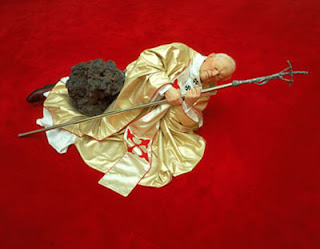And how would my questions have been answered if it hadn't been for Kevin? We were thrilled to have found ourselves a Beefeater (or Yeoman Warder) to show us around; our evident enthusiasm earning us vultures a gruff 'I like you lot' at the start of the tour. And boy oh boy did we like Kev back. Every five minutes, our wandering attention would be set on the straight and narrow by a single word from Kevin such as 'MURRRDER', 'DEATH' or 'TORRRTURE' being shouted so loudly it even made headless old Ann Boleyn turn in her grave.
Along with telling us that his most frequently asked question is whether any of the Beefeaters are vegetarian, Kevin did disclose some fascinating information. Did you know that after an inquiry carried out under Queen Victoria, they found 1500 bodies buried in a mass grave beneath the tower's chapel, only 350 of which have been recorded? Did you know that the Yeoman Warders all live at the tower with their families and that their yellow, red and navy uniforms are worth £10,000 each? Did you know that if the famous ravens (looked after by the Yeoman Warder Ravenmaster) ever leave the tower, the monarchy and the tower itself will supposedly crumble? And did you know that the job title 'Yeoman Warder Ravenmaster' has to be the bestest job title on earth?
On entering the Bloody Tower (obviously causing much amusement amongst the vultures; sounding more like a tower people are fed up with rather than a torture chamber), we saw torture contraptions with fantastic names like 'The Stretcher' and 'The Scavenger's Daughter'. We learnt that Guy Fawkes had been kept in a room in this tower before he was Hanged, Drawn and Quartered (which involves being hanged, being sliced into four quarters and then having your insides drawn out and distributed to the four corners of the country). Point of information Medieval Period, it should actually be Hanged, Quartered and Drawn, but I guess what it is titled is probably not a top-of-the-list priority when it comes down to it. We then spent some time in the chapel of St. Peter ad Vincula where three Queens of England; Anne Boleyn, Catherine Howard and Lady Jane Grey are buried. And from there, we headed to the fairly long but fast moving queue to paradise: The Crown Jewels.
After watching Queen Elizabeth II's Coronation 5 times on repeat and after my mother and a Yeoman Warder had struck up a pretty serious relationship, we made our way to the rocks. Jumping onto a hilarious moving carpet that encouraged a fair few 'could passengers of flight AV354 to London Heathrow boarding at Gate 14 make their way to the gate as quickly as possible' comments, we drifted past crown after crown, diamond after diamond. The damn thing moved so fast, I did five circuits.
Based on sparkliness, there is absolutely no doubt which monarch I would have liked to have been. Not only did George V have a crown studded with 6, 100 diamonds as well as rubies, sapphires and emeralds, but he was also responsible for placing Cullinan I into the Sovereign Sceptre. Listen to me; wannabe director of Garrard much? The Cullinan diamond is the world's largest rough diamond to have ever been found. It was cut into nine smaller stones, the biggest of which (Cullinan I) sits in the Sceptre and weighs 530.4 carats. But George's crown, The Imperial Crown of India, has not been worn since George V complained it was too heavy on his head. With sparkles like that and comments like this, there was no question in my mind which side of the fence George was sitting on. Bad news Mary of Teck...
Gold looks so boring when there are so many rocks knocking about (forgive me father for I have sinned). Its a bit like not wanting Ashton Kutcher because you've got Johnny Depp... if you get me? Having said that, there was a golden vessel that did catch my attention: The Grand Punch Bowl. 1 metre wide and able to hold 144 bottles of wine. And solid gold. Why on earth am I not in the royal family?
Sauntering out of the tower via Henry VIII's armour and a Yeoman Warder who loved having his picture taken so much I'd be surprised if he wasn't auditioning for England's Next Top Model, I felt extremely happy. Not only was the sun shining, but it was 2pm on a Saturday, I had learnt a million and one things already today, and I felt so proud of our country's extraordinary history and unique traditions.


To buy tickets to the Tower of London, visit: Tower of London
For more information about our wonderful Raven drawer Megan Niven, email culture.vultures@hotmail.co.uk


+em.jpg)
.jpg)





